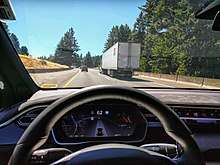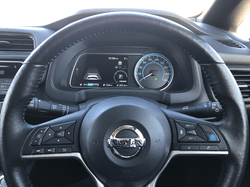Advanced driver-assistance systems
Advanced driver-assistance systems (ADAS), are electronic systems that help the vehicle driver while driving or during parking. When designed with a safe human-machine interface, they are intended to increase car safety and more generally road safety. ADAS systems use electronic technology such as microcontroller units (MCU), electronic control units (ECU),[2] and power semiconductor devices.[3]

Most road accidents occur due to human error.[4] Advanced driver-assistance systems are systems developed to automate, adapt and enhance vehicle systems for safety and better driving. The automated system which is provided by ADAS to the vehicle is proven to reduce road fatalities, by minimizing the human error.[5] Safety features are designed to avoid collisions and accidents by offering technologies that alert the driver to potential problems, or to avoid collisions by implementing safeguards and taking over control of the vehicle. Adaptive features may automate lighting, provide adaptive cruise control and collision avoidance, pedestrian crash avoidance mitigation (PCAM), incorporate satnav/traffic warnings, alert driver to other cars or dangers, lane departure warning system, automatic lane centering, show what is in blind spots, or connect to smartphones for navigation instructions.
Description
Modern vehicles today have advanced driver-assistance systems integrated to their electronics and manufacturers refresh their car models to add more of these features into their cars. Early advanced driver-assistance systems include electronic stability control, anti-lock brakes, lane departure warning, adaptive cruise control and traction control. These systems can be affected by mechanical alignment adjustments. This has led many manufacturers to require electronic resets for these systems, after a mechanical alignment is performed.[6]
ADAS relies on inputs from multiple data sources, including automotive imaging, LiDAR, radar, image processing, computer vision, and in-car networking.[7] Additional inputs are possible from other sources separate from the primary vehicle platform, such as other vehicles, referred to as Vehicle-to-vehicle (V2V), or Vehicle-to-Infrastructure (V2X), such as mobile telephony or WiFi data network systems.
Mobileye, an Intel company, has developed a comprehensive suite of ADAS systems that range on the spectrum of passive and active. Passive ADAS safety systems like the Lane Departure Warning (LDW) alerts the driver of unintended/unindicated lane departure; and Forward Collision Warning (FCW) indicates that a collision is imminent. In contrast, active ADAS safety systems like Automatic Emergency Braking (AEB) identifies the imminent collision and brakes without any driver intervention, Adaptive Cruise Control (ACC) adjusts the host vehicle speed, Lane Keeping Assist (LKA) and Lane Centering (LC) automatically steer the vehicle to stay within the lane boundaries, and Traffic Jam Assist (TJA) is a combination of both ACC and LC.[8]
Advanced driver-assistance systems are one of the fastest-growing segments in automotive electronics,[9] with steadily increasing rates of adoption of industry-wide quality standards, in vehicular safety systems (ISO 26262), developing technology specific standards, such as IEEE 2020 for Image Sensor quality[10] and communications protocols such as the Vehicle Information API.[11]
Next-generation ADAS will increasingly leverage wireless network connectivity to offer improved value by using car-to-car (also known as Vehicle to Vehicle, or V2V) and car-to-infrastructure (also known as Vehicle to Infrastructure, or V2X) data.[12]
Developments
In March 2014, the US Department of Transportation's National Highway Traffic Safety Administration (NHTSA) announced that it will require all new vehicles under 10,000 pounds (4,500 kg) to have rear view cameras by May 2018.[13] The rule was required by Congress as part of the Cameron Gulbransen Kids Transportation Safety Act of 2007. The Act is named after two-year-old Cameron Gulbransen, who was killed when his father failed to see the toddler, and accidentally backed his SUV over him in the family's driveway.[14]
GM offers vibrating seat warning, in Cadillacs starting with the 2013 Cadillac ATS. If the driver begins drifting out of the traveling lane of a highway, the seat vibrates on the side of the seat in the direction of the drift, warning the driver of danger. The Safety Alert Seat also provides a vibrating pulse on both sides of the seat when a frontal threat is detected.[15] The system was first offered by Citroen in 2006 as part of its AFIL (Lane Departure Warning) system. See: Driver drowsiness detection.
Alcohol ignition interlock devices do not allow the driver to start the car if the breath alcohol level is above a predescribed amount.[16] The Automotive Coalition for Traffic Safety and the National Highway Traffic Safety Administration have called for a Driver Alcohol Detection System for Safety (DADSS) program to put alcohol detection devices in all cars.[17]
In September 2016, the NHTSA published the Federal Automated Vehicles Policy,[18] which describes the U.S. Department of Transportation's policies related to highly automated vehicles (HAV) which range from vehicles with advanced driver-assistance systems features to autonomous vehicles.
Implementations

- Tesla Autopilot
- Nissan ProPilot Assist
- Mobileye
- openpilot
- Volvo IntelliSafe
- Mercedes-Benz Distronic Plus
- MOVON
Feature examples
- Adaptive cruise control (ACC)
- Glare-free high beam and pixel light
- Adaptive light control: swiveling curve lights
- Anti-lock braking system
- Automatic parking
- Automotive head-up display
- Automotive navigation system with typically GPS and TMC for providing up-to-date traffic information
- Automotive night vision
- Backup camera
- Blind spot monitor
- Collision avoidance system (Pre-crash system)
- Crosswind stabilization
- Cruise control
- Driver drowsiness detection
- Driver Monitoring System
- Electric vehicle warning sounds used in hybrids and plug-in electric vehicles
- Electronic stability control
- Emergency driver assistant
- Forward Collision Warning (FCW)
- Intersection assistant
- Hill descent control
- Hill-Start Assist
- Intelligent speed adaptation or intelligent speed advice (ISA)
- Lane centering
- Lane departure warning system (LDW)
- Lane change assistance
- Parking sensor
- Pedestrian protection system
- Rain sensor
- Surround View system
- Tire Pressure Monitoring
- Traction control system
- Traffic sign recognition
- Turning assistant
- Vehicular communication systems
- Wrong-way driving warning
See also
- Autotech
- EuroFOT
- Intelligent Transportation System
- Traffic psychology
References
- Epstein, Zach (2016-07-21). "Tesla Autopilot Crash Avoidance Model S Autopilot saves man's life". BGR. Retrieved 2016-08-26.
- "Capturing the opportunity in advanced driverassistance systems". McKinsey on Semiconductors. McKinsey & Company (5): 49–59. Winter 2015. Retrieved 24 October 2019.
- "Automotive Industry Now the Third Largest End Market for Power Semiconductors, IHS Says". IHS Technology. IHS Markit. September 3, 2015. Retrieved 25 October 2019.
- Brookhuis, Karel A.; de Waard, Dick; Janssen, Wiel H. (2019). "Behavioural impacts of advanced driver assistance systems–an overview". European Journal of Transport and Infrastructure Research.
- Umar Zakir Abdul, Hamid; et al. (2017). "Autonomous Emergency Braking System with Potential Field Risk Assessment for Frontal Collision Mitigation". 2017 IEEE Conference on Systems, Process and Control (ICSPC). Retrieved 14 March 2018.
- "Things to consider when choosing an aligner | Pro-Align". Pro-Align. Archived from the original on 2018-07-09. Retrieved 2017-12-05.
- "UK: AutoSens 2016 conference bring together ADAS specialists". Sense Media Group. 2016-03-01. Retrieved 2016-03-01.
- "ADAS". Mobileye. Retrieved 2020-05-05.
- Ian Riches (2014-10-24). "Strategy Analytics: Automotive Ethernet: Market Growth Outlook | Keynote Speech 2014 IEEE SA: Ethernet & IP @ Automotive Technology Day" (PDF). IEEE. Retrieved 2014-11-23.
- "UK: IEEE 2020 - Automotive System Image Quality Working Group". Sense Media Group. 2016-06-08. Retrieved 2016-06-08.
- "UK: Vehicle Information Access API". W3C. 2016-06-08. Retrieved 2016-06-08.
- "ADAS Definition". Autoconnectedcar.com. Archived from the original on 2012-06-10. Retrieved 2014-07-15.
- "NHTSA Announces Final Rule Requiring Rear Visibility Technology | National Highway Traffic Safety Administration (NHTSA)". Nhtsa.gov. 2014-03-31. Retrieved 2014-07-15.
- "U.S. DOT Proposes Rear View Visibility Rule to Protect Kids and the Elderly | National Highway Traffic Safety Administration (NHTSA)". Nhtsa.gov. 2010-12-03. Archived from the original on 2014-07-14. Retrieved 2014-07-15.
- "Cadillac XTS Safety Seat Alerts Drivers to Dangers". Media.gm.com. 2012-03-27. Retrieved 2014-07-15.
- Lynn Walford @MobiWriter (2014-06-11). "How ignition interlock devices can stop drunk drivers in their tracks". TechHive. Retrieved 2014-07-15.
- "Why are we here? | Alcohol Detection". Dadss.org. Archived from the original on 2014-07-14. Retrieved 2014-07-15.
- "Federal Automated Vehicles Policy". Nhtsa.gov. 2016-09-01. Retrieved 2017-09-06.
External links
- Driver Assist Technologies Insurance Institute for Highway Safety (IIHS)
| Wikimedia Commons has media related to Advanced driver assistance systems. |